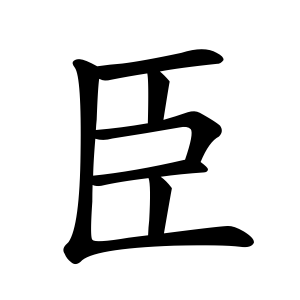臣
- minister, subject, one who serves;
It represents a government official or a subordinate serving a ruler.
Etymology
Its origin is a pictograph depicting a bent body with eyes wide open upward, believed to represent the eyes of a slave. Over time, the meaning expanded from "slave" to "minister" who serves the ruler.
In Japanese writing, the character is sometimes written with the box component (匚) split into two strokes, resembling the character 巨.
Usage in Korean
When used as a radical, it conveys meanings related to slaves or actions involving bowing the head and bending the body.
Characters with 臣
Words that derived from 臣
臣
신하
신
sinha
sin
Kangxi radical:131
Strokes:6
Unicode:U+81E3
Cangjie input:
- 尸中尸中 (SLSL)
Composition:
- ⿺ 𠃊 ⿳ 丅 𠃍 丅
- ⿷ 匚 ⿳ 丨 コ 丨
- ⿻ 巨 ⿱ 丨 丨
